The Medial Surface of the Auricle: Historical and Recent Maps. What Are the Possible Expectations of the “Thumb-Index Technique”
Abstract
:1. Introduction:
1.1. The Medial Surface of the Auricle (or MSotA)
1.2. Historical Maps
1.3. Recent Maps
1.4. Critical Points to Mapping the MSotA
1.5. The Thumb-Index Technique
2. Materials and Method
- (1)
- How many years have you been practicing auricular acupuncture (AA)?
- (2)
- Do you use the MSotA when practicing AA?
- (3)
- On a scale from 1 to 10 (where 1 is easy and 10 is very difficult), how difficult is it for you to locate therapeutic areas on the MSotA?
- (4)
- On a scale from 1 to 10 (where 1 is not important and 10 is very important), how important would it be to have a quick and simple method to be able to locate therapeutic areas on the MSotA?
- (5)
- Do you know the thumb-index technique (or TIT)? After a brief explanation of the TIT, the last two questions were asked.
- (6)
- On a scale from 1 to 10 (where 1 is not much and 10 is a lot), how much do you think TIT would help locate therapeutic areas on the MSotA?
- (7)
- On a scale from 1 to 10 (where 1 is never and 10 is always), now that you know this method would you include it in your everyday AA practice?
3. Results
4. Discussion and Conclusions
Author Contributions
Funding
Institutional Review Board Statement
Informed Consent Statement
Data Availability Statement
Conflicts of Interest
References
- Peuker, E.T.; Filler, T.J. The nerve supply of the human auricle. Clin. Anat. 2002, 15, 35–37. [Google Scholar] [CrossRef] [PubMed]
- WHO. Report ok Working Group on Auricular Acupuncture Nomenclature, Lyon, France, 28–30 November 1990. Available online: http://whqlibdoc.who.int/hq/1991/WHO_TRM_91.2.pdf (accessed on 20 October 2020).
- Wang, L.; Zhao, B.; Zhou, L. Status and strategies analysis on international standardization of auricular acupuncture points. J. Tradit. Chin. Med. 2013, 33, 408–412. [Google Scholar] [CrossRef] [Green Version]
- Wirz-Ridolfi, A. The history of ear acupuncture and ear cartography: Why precise mapping of auricular points is important. Med. Acupunct. 2019, 31, 145–156. [Google Scholar] [CrossRef] [PubMed] [Green Version]
- Zang, Z. Essential Techniques for Massage; People’s Medical Publishing House: Beijing, China, 1955. [Google Scholar]
- Nogier, P. Acupuncture of the Ear Pavilion. Dtsch. Zeitshrift Akupunkt. DZA 1957, VI, 25–35. (In German) [Google Scholar]
- Romoli, M. Ear Acupuncture: Historical Abstract—Differences of Ear Cartography between the East and the West. Dtsch. Zeitshrift Akupunkt. DZA 2010, 53, 24–33. [Google Scholar] [CrossRef]
- Jarricot, H.; Wong, M. De l’auriculothérapie. Méridiens 1973, 21–22, 85–137. [Google Scholar]
- Nogier, P.F.M.; Bourdiol, R.J.; Bahr, F. Loci auriculomedicinae. Maissonneve 1975. Available online: https://scholar.google.com/scholar_lookup?title=Loci+Auriculomedicinae&author=P.+F.+M.+Nogier&author=R.+J.+Bourdiol&author=F.+Bahr& (accessed on 13 November 2020).
- Romoli, M. A contribution to the study of new areas of the ear lobe for treatment of migraine and cephalalgia whith acupuncture. In Proceedings of the 1st Czechoslovak Congress of Acupuncture, Brno, Czech Republic, 3–6 June 1981. [Google Scholar]
- China Association of Acupuncture and Moxibustion. The project of the standardi- zation of auricular acupuncture points. J. Tradit. Chin. Med. 1988, 6, 75–77. [Google Scholar]
- Oleson, T. Auricolotherapy Manual: Chinese and Western Systems of Ear Acupuncture, 3rd ed.; Churchill Livingstone: London, UK, 2003. [Google Scholar]
- Oleson, T. Standardized Ear Acupuncture Nomenclature Utilizing Auricular Landmarks and 3-D Graphic Imaging for Delineating Different Auricular Zones. Med. Acupunct. 2019, 31, 145–156. [Google Scholar] [CrossRef]
- Romoli, M.; Mazzoni, R. The validation of a new system of transcription of acupuncture points on the ear: The auricular sectogram. Ger. J. Acupunct. Relat. Tech. 2009, 52, 7–10. [Google Scholar] [CrossRef]
- Alimi, D. L’auriculothérapie Médicale; Elsevier: Amsterdam, The Netherlands, 2017. [Google Scholar]
- Alimi, D.; Chelly, J.E. New Universal Nomenclature in Auriculotherapy. J. Altern. Complement. Med. 2018, 24, 7–14. [Google Scholar] [CrossRef] [PubMed]
- Wang, L.; Yang, J.; Zhao, B.; Zhou, L.; Wirz-Ridolfi, A. The similarities between the World Federation of Acupuncture–Moxibustion Societies’ standard for auricular acupuncture points and European system of auriculotherapy points according to Nogier and Bahr. Eur. J. Integr. Med. 2016, 8, 817–834. [Google Scholar] [CrossRef] [Green Version]
- Rong, P.J.; Zhao, J.J.; Wang, L.; Zhou, L.Q. Analysis of advantages and disadvantages of the location methods of international auricular acupuncture points. Evid. Based Complementary Altern. Med. 2016, 2016. [Google Scholar] [CrossRef] [PubMed] [Green Version]
- Alimi, D.; Geissmann, A.; Gardeur, D. Auricular acupuncture stimulation measured on functional magnetic resonance imaging. Med. Acupunct. 2002, 13, 18–21. [Google Scholar]
- Alimi, D.; Geissmann, A.; Gardeur, D.; Bahr, F. Study in fMRI of the stimulation of the auricular areas of the knee as the French–German and Chinese localizations. J. Radiol. Photon. 2014, 125, 133–141. [Google Scholar]
- Romoli, M.; Allais, G.; Airola, G.; Benedetto, C.; Mana, O.; Giacobbe, M.; Pugliese, A.M.; Battistella, G.; Fornari, E. Ear acupuncture and fMRI: A pilot study for assessing the specificity of auricular points. Neurol. Sci. 2014, 35 (Suppl. 1), 189–193. [Google Scholar] [CrossRef] [PubMed]
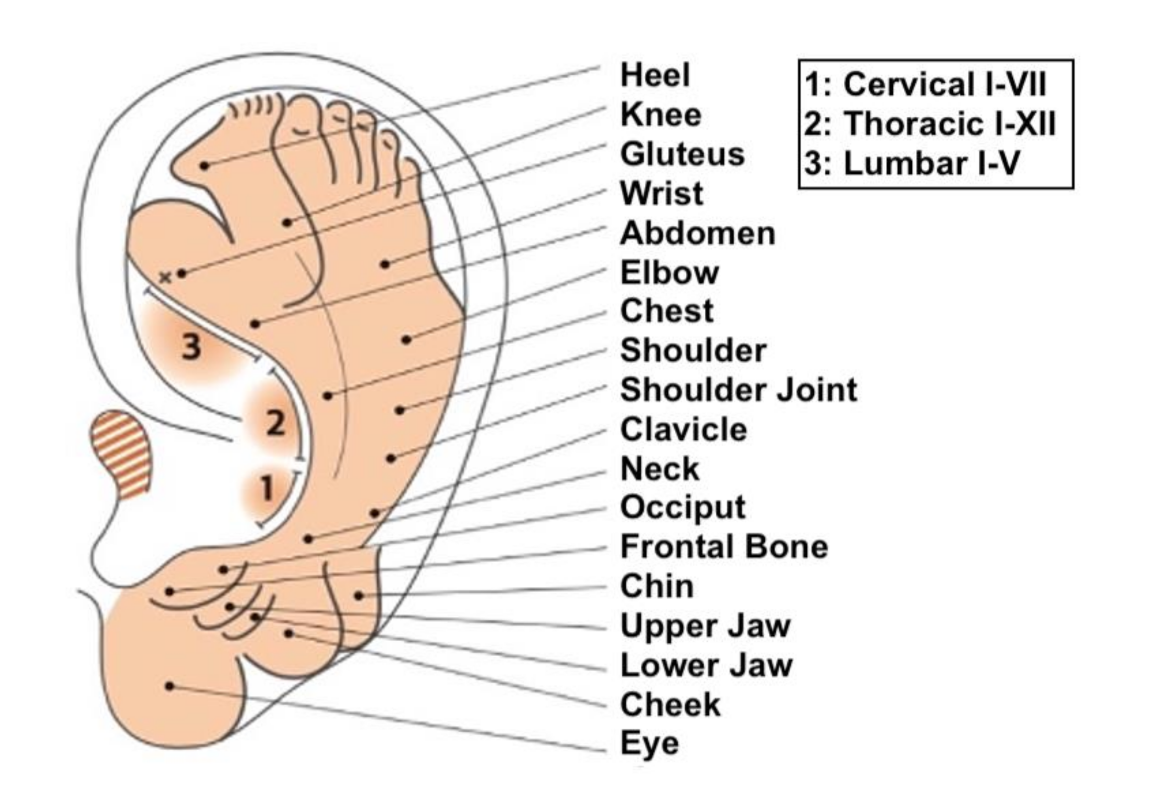
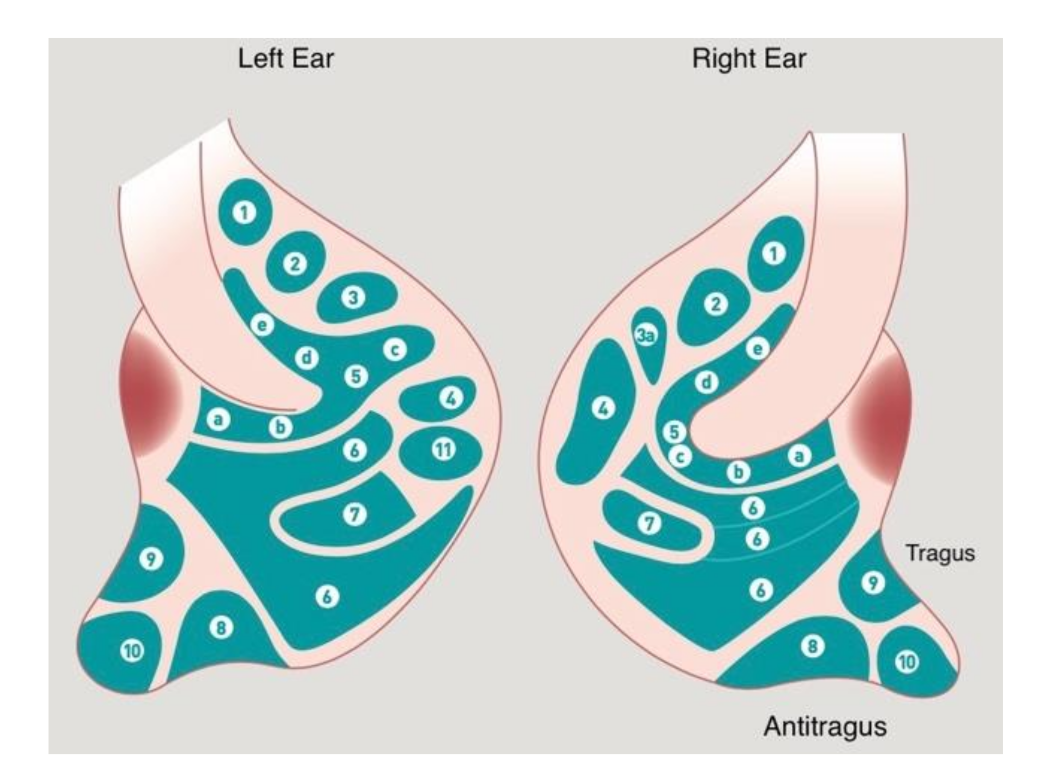
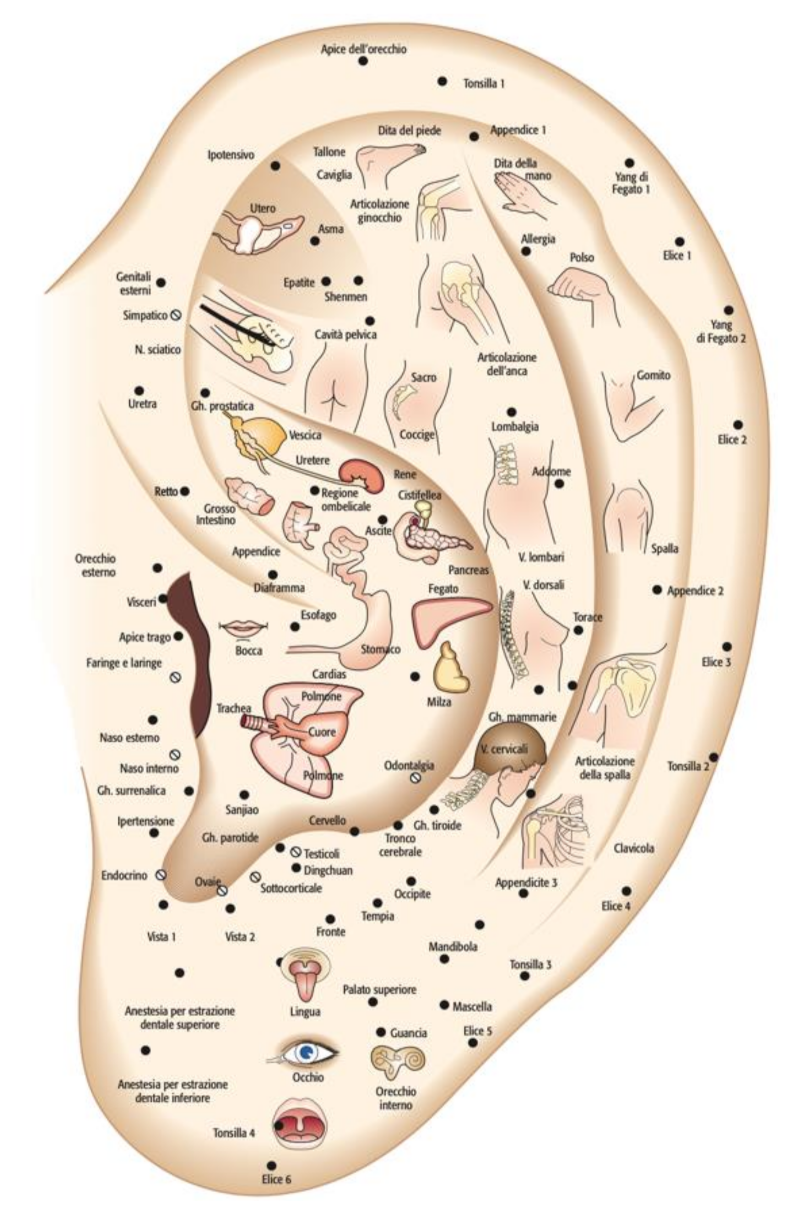
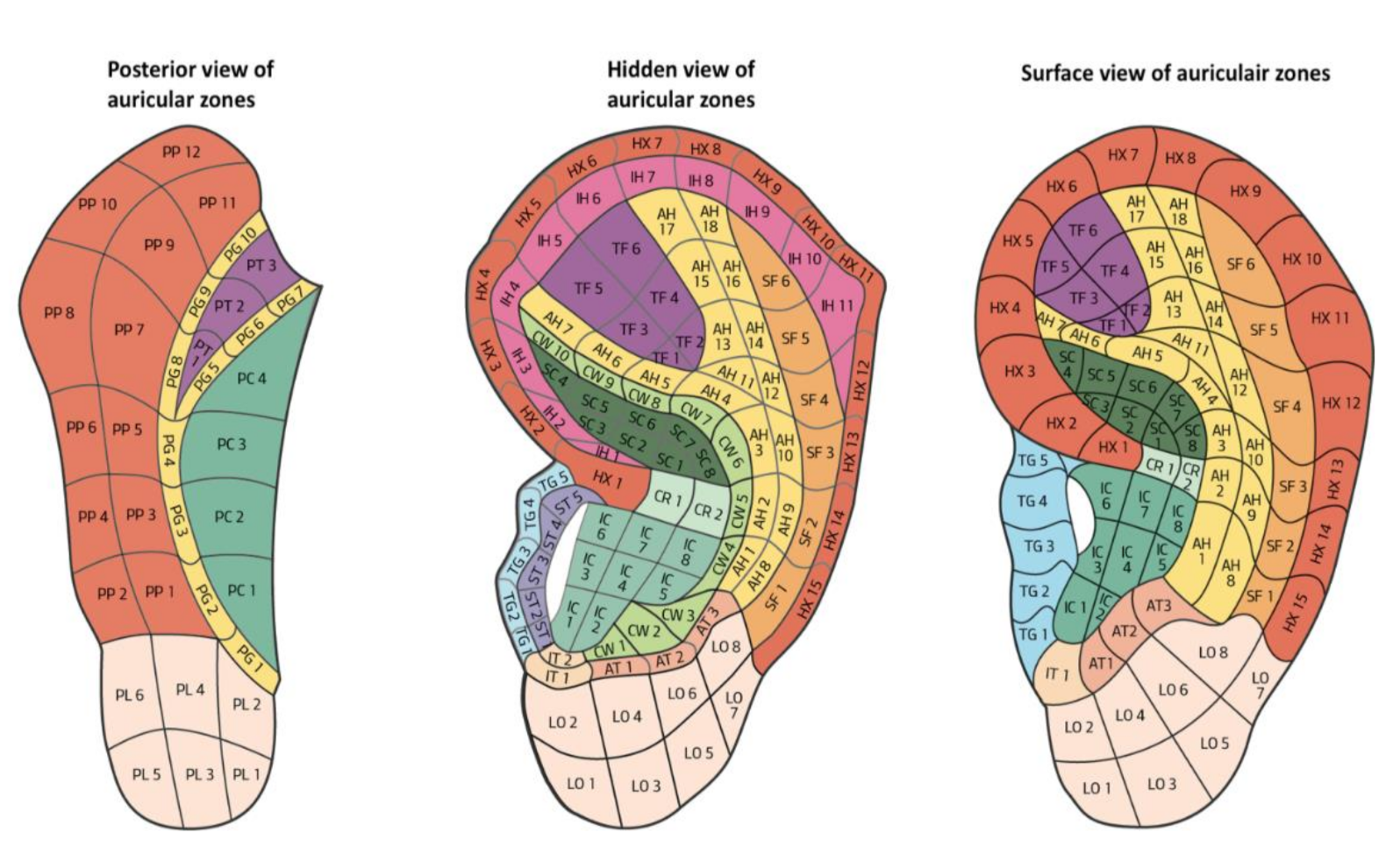
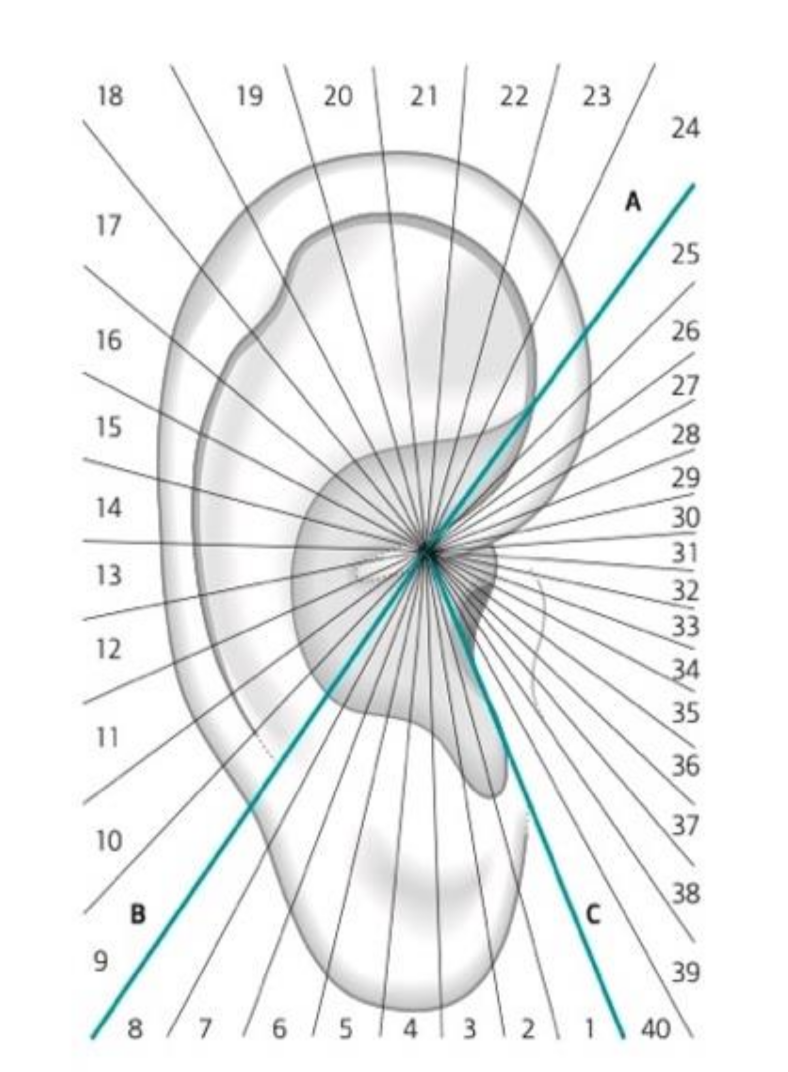
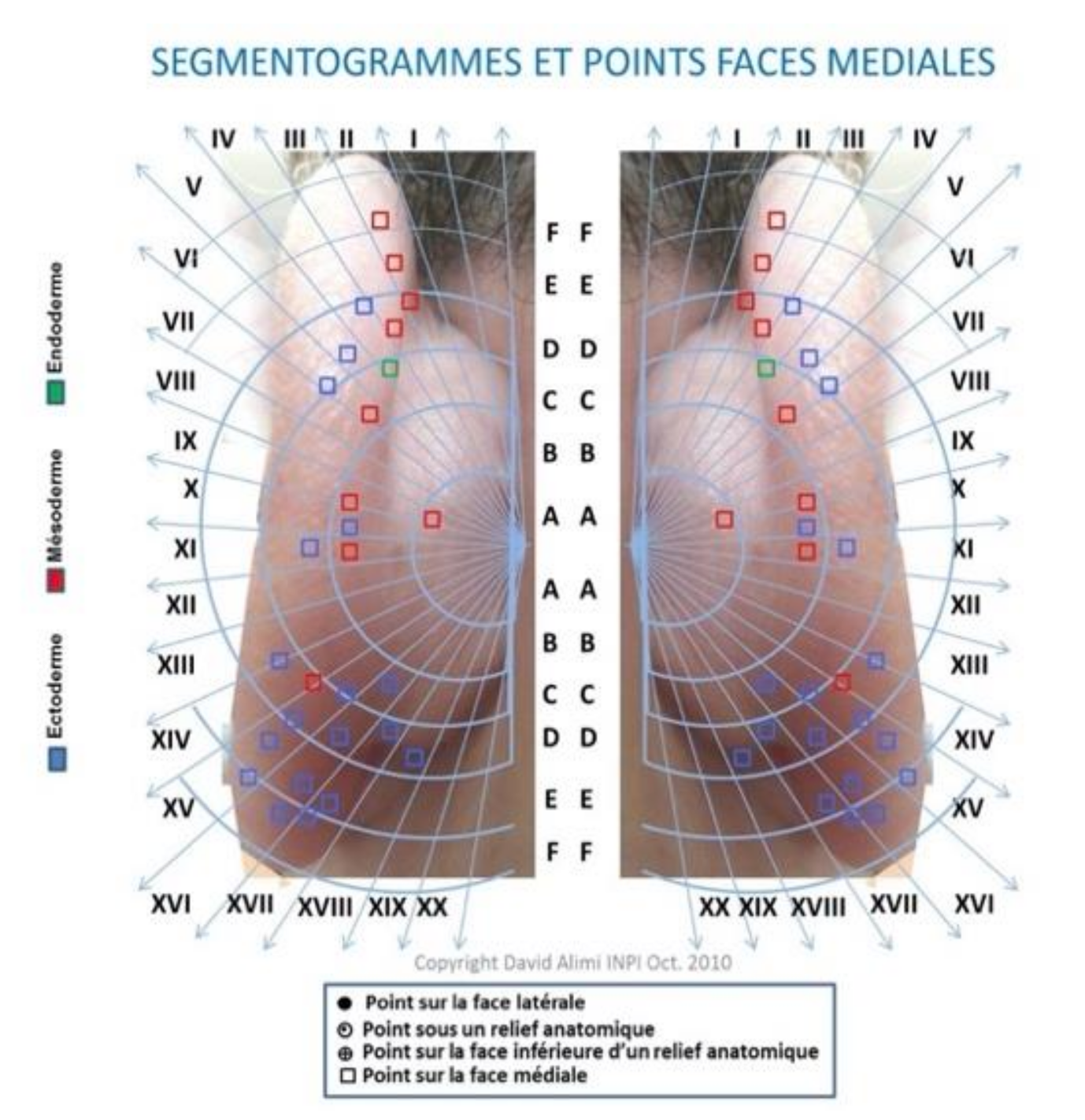
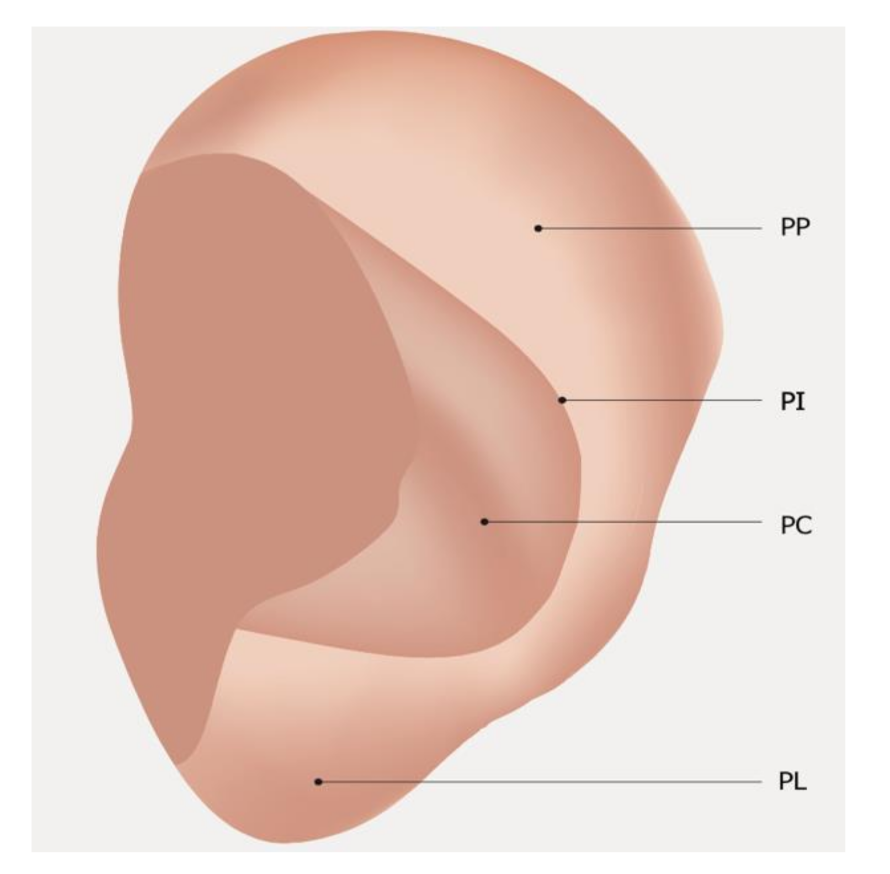

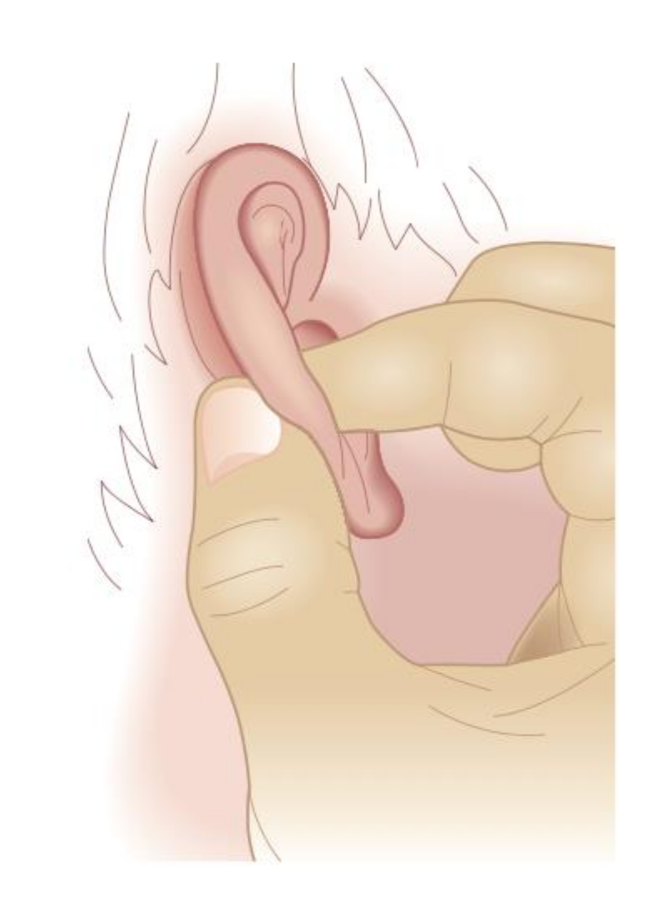
| Question | Mean | SD | Max Score | Min Score |
|---|---|---|---|---|
| 1 | 4.81 | ±4.92 | 20 | 1 |
| 3 | 6.14 | ±2.17 | 10 | 1 |
| 4 | 8.25 | ±2.25 | 10 | 1 |
| 5 | 0.81 | ±0.39 | 1 | 0 |
| 6 | 8.17 | ±1.85 | 10 | 1 |
| 7 | 8.25 | ±1.17 | 10 | 1 |
Publisher’s Note: MDPI stays neutral with regard to jurisdictional claims in published maps and institutional affiliations. |
© 2022 by the authors. Licensee MDPI, Basel, Switzerland. This article is an open access article distributed under the terms and conditions of the Creative Commons Attribution (CC BY) license (https://creativecommons.org/licenses/by/4.0/).
Share and Cite
Lovato, A.; Ceccherelli, F.; Gagliardi, G.; Postiglione, M. The Medial Surface of the Auricle: Historical and Recent Maps. What Are the Possible Expectations of the “Thumb-Index Technique”. Medicines 2022, 9, 13. https://doi.org/10.3390/medicines9020013
Lovato A, Ceccherelli F, Gagliardi G, Postiglione M. The Medial Surface of the Auricle: Historical and Recent Maps. What Are the Possible Expectations of the “Thumb-Index Technique”. Medicines. 2022; 9(2):13. https://doi.org/10.3390/medicines9020013
Chicago/Turabian StyleLovato, Antonello, Francesco Ceccherelli, Giuseppe Gagliardi, and Marco Postiglione. 2022. "The Medial Surface of the Auricle: Historical and Recent Maps. What Are the Possible Expectations of the “Thumb-Index Technique”" Medicines 9, no. 2: 13. https://doi.org/10.3390/medicines9020013
APA StyleLovato, A., Ceccherelli, F., Gagliardi, G., & Postiglione, M. (2022). The Medial Surface of the Auricle: Historical and Recent Maps. What Are the Possible Expectations of the “Thumb-Index Technique”. Medicines, 9(2), 13. https://doi.org/10.3390/medicines9020013






